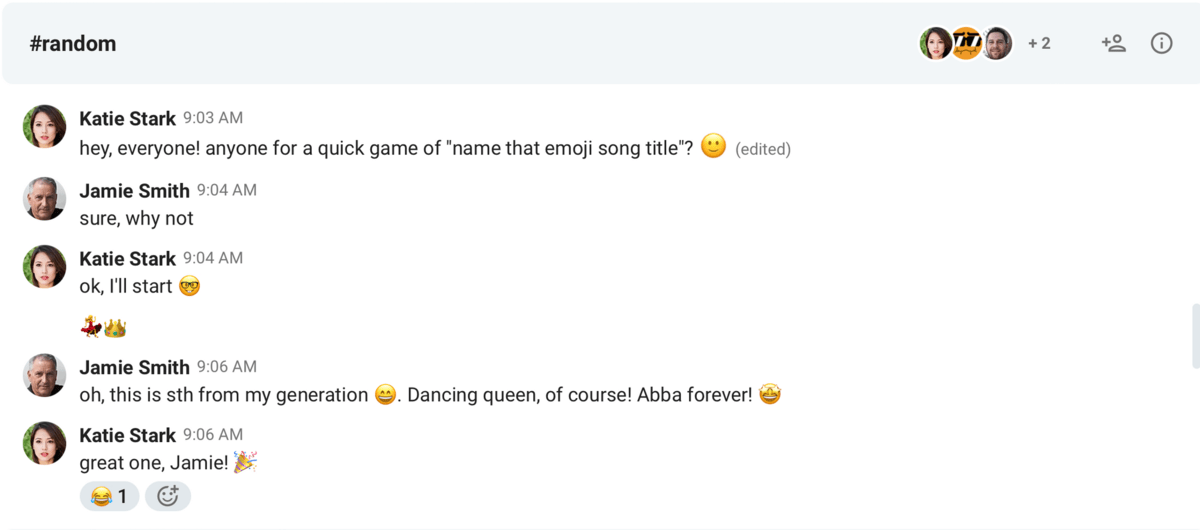Tired of all work and no play?
What’s the first image that pops into your head when you think of team-building games?
If it’s the one with your team members idling about, worry not. We’re putting this common misconception to rest.
Apart from positively impacting employee mental health, team-building activities can be directed towards a specific outcome so that they serve your best business purpose.
In this guide, we will give you insight into some evidence-based tools for creating a collaborative and pleasant working environment.
We’ll cover over 40 best team-building activities to improve communication, in categories such as:
- Best overall communication team-building games,
- Icebreaker team-building activities,
- 5-minute team-building activities,
- Problem-solving team-building activities, and
- Team-building activities for specific communication situations.
In addition, we’ll define team-building games and offer a list of reasons why you should implement them in your team events.
A healthy dose of fun has never done harm, so let’s dive deeper into some of the best communication team-building activities.

What are team-building games?
Team-building games are activities that aim to:
- Improve team performance and effectiveness,
- Create a fun experience for a team to share,
- Build trust between team members,
- Improve communication within a team,
- Help team members talk about important issues openly and constructively,
- Help a team collaborate on a shared goal, and
- Help a team feel more connected.
Usually, team-building games are practiced during team-building events. However, some of the games and activities can be part of a quick session in your regular meetings or a team development workshop.
Depending on your specific objectives, you’ll pick from a different category of team-building games. These can include anything from getting to know each other games and icebreakers, to team communication and purpose and alignment activities.
In this guide, we will list all the most popular team-building activities aimed at improving team communication.
So, whether you need to solve your miscommunication issues or just need a quick brush up on your team’s communication skills, you’ll find a perfect exercise in our list of over 40 best communication team-building activities.
5 Best team-building activities to improve communication
Topping our list of best communication team-building activities, we have our 5 best team-building games and exercises that will help you build a dream team of super-effective communicators.

#1: One-syllable mystery
Objective: Improving your team members’ communication style and their focus
Time: 15 minutes
Materials and resources: Index cards with different terms
Instructions:
- The team members split into two separate teams, A and B. Each team selects one person to be their Clue Giver.
- The Clue Giver draws one card and tries to lead the teammates to guess the mysterious person/place/object written on the card using only one-syllable words. For example: “This is what you need to buy things” (Money).
- While the Clue Giver from one team is trying to explain the term, members of the opposite team listen attentively and pick out mistakes. If they catch the Clue Giver using multi-syllable words, the opposing team is not given any points.
#2: Secret agenda
Objective: Fostering your team’s cooperation and collaboration abilities
Time: 15 minutes
Materials and resources: Blank cards and pens
Instructions:
- After getting a card and a pen, the participants think of a strange word or a phrase they will write on their cards. They are not supposed to share their strange words with any of the team members.
- The game starts with one person saying, “Once upon a time….”
- The team member sitting next to them continues the story by adding one of their strange secret words. For example, “Once upon a time, there was a hysterical cucumber whose blindfolded submarine texted him every Saturday morning….”
- The story goes on until the last team member reaches a conclusion.
#3: Yin and Yang
Objective: Encouraging asking purposeful questions and fostering meaningful team interaction
Time: 45–60 minutes
Materials and resources: A list of things that usually go in pairs, such as peanut butter and jelly, mac and cheese, king and queen, etc. You need to write these things down on post-it notes and stick individual notes on team members’ backs.
Instructions:
- Each team member goes around the room and tries to discover the mystery word on their back by asking questions about it. They could ask something like, “Am I food?”, “Am I an animal?”, “Can you drink me?”
- Upon discovering their secret identity, team members try to find their match.
#4: Blind design
Objective: Improving your team’s ability to give instructions
Time: 40 minutes
Materials and resources: Blank paper sheets, pens, a variety of objects or pictures
Instructions:
- First, the teammates sit in pairs leaning back to back.
- One team member gets a blank sheet of paper and a pen, and the other teammate gets an object or a picture. A time limit is set.
- The person holding the secret object/picture gives detailed instructions to their teammate about the object’s traits. The other teammate draws the secret object as accurately as possible based on the given instructions.
- When the time is up, everyone compares their drawing with the original and teammates discuss the complexity of the task.
#5: Listen up
Objective: Encouraging open communication and strengthening your team members’ listening skills
Time: 25–30 minutes
Materials and resources: Cards with interesting (but not too controversial) topics
Instructions:
- Team members split into pairs, and each pair gets a set number of index cards (depending on your team size).
- One member of each pair draws a card blindly and has 3 minutes to talk about their opinion on the topic on the card.
- Their partner listens without interrupting, and then, they have one minute to summarize what the first person has said. The trick is not to agree, disagree, or comment on their partner’s opinion — only recap.
- The roles then switch, and the game starts over.
- Team members later on discuss the challenges of having to listen with an open mind, and share how they can use the lessons from this activity at work.
Communication team-building activities for specific communication situations
Now that we’ve covered the top 5 most popular communication team-building activities, it’s time to continue our countdown with some specific categories to make sure every team’s need is being answered.
Every business environment implies frequent encounters with different communication situations. Sometimes they can be as manageable as an update meeting.
However, occasionally they turn into a hard-to-handle challenging task.
This is where team-building activities tailored explicitly for particular communication situations come in handy.
Whatever the outcome you would like to achieve, we’ve compiled some of the best team-building games specifically designed to promote effective team communication.
We’ve divided them into categories reflecting different communication situations.
Specifically, in this section, we’re going to tell you more about:
- Icebreaker team-building games,
- Drawing team-building activities,
- 5-minute team-building activities,
- Problem-solving team-building activities,
- Virtual team-building activities,
- Outdoor team-building activities,
- Conflict resolution team-building activities, and
- Feedback team-building activities.
Let’s dive in for more details.
Communicate more effectively with Pumble
Icebreaker team-building activities
A well-prepared icebreaker activity can do wonders for creating a collaborative environment.
You can use icebreaker team communication activities to get to know each other or establish a strong connection between team members.
The following icebreaker activities will provide solid grounds for improving your team’s communication process from the get-go.

#1: Quotes
Objective: Encouraging your team to get to know each other and connect in a meaningful way
Time: 30 minutes
Materials and resources: A set of cards with inspirational quotes that relate to your industry or company culture and values
Instructions:
- Team members split into pairs. One member from each pair chooses one quote card blindly and reads the quote out loud.
- They then discuss the meaning of the quote with their partner for a set amount of time (5 minutes, for example).
- In the next round, the second team member from each pair draws another quote and the discussion continues.
#2: A penny for your thoughts
Objective: Encouraging your team to get to know each other and bond on a personal level
Time: 30 minutes
Materials and resources: A jar filled with coins that are not dated older than the youngest person playing the game
Instructions:
- Each team member draws one coin from the jar.
- They should look at the date the coin was issued and think of a special event that happened to them that year. It could be anything, from learning how to swim to graduating from college.
- The game continues until every team member finishes sharing their memorable story.
#3: It’s my birthday
Objective: Enhancing your team’s non-verbal communication skills and teaching cooperation
Time: 15 minutes
Materials and resources: Nothing but your team!
Instructions:
- The goal of this game is to get the team members to line up according to the month of their birthday — from January to December. They can only use non-verbal communication, such as gestures or movements.
- When they finish lining up, everyone can share their birthday month out loud and check how successful they were in completing the task without verbal communication.
#4: Number 45
Objective: Having your team get to know each other better
Time: 15 minutes
Materials and resources: Nothing but your team!
Instructions:
- The team members pair up and interview each other for no longer than 2 minutes.
- Everyone gets an additional 5 minutes to prepare the introduction for their partner. The introduction can consist of exactly 45 words.
- Other teammates listen carefully and stop their colleagues if they exceed the word limit.
#5: Pop the balloon
Objective: Improving your team’s communication style
Time: 30 minutes
Materials and resources: A group of interesting questions, balloons
Instructions:
- The facilitator prepares a list of questions they think the group might find interesting. For example, “What is the most useless talent you have?”, “What is one ridiculous thing someone has tricked you into believing?”, “What will finally break the Internet?” etc.
- Each question is placed into a balloon, and the balloon is blown up.
- Every team member catches one balloon, pops it, and responds to the question from the inside of the balloon. The trick is not to use filler words when responding, such as ‘’um’’, ‘’like’’, ‘’kind of’’, ‘’you know’’, ‘’okay’’, etc.
🎓 Pumble Pro Tip
For more ideas on how to help your team ease into virtual meetings more effectively, be sure to check out our extensive list of icebreaker ideas for virtual teams:
Drawing team-building activities
Fostering a positive communication environment in a workplace does not have to focus on verbal communication only.
Sometimes, your team members’ interaction and collaboration depend on their abilities to leap out of the box and embrace a creative mindset using some elements of visual communication instead.
Try introducing the following drawing activities if you are looking for novel methods to strengthen the bond among your teammates.

#1: Team pictionary
Objective: Strengthening your team’s communication and introducing some fun competition
Time: 30–45 minutes
Materials and resources: Cards with industry words, markers, and a large surface to draw on
Instructions:
- The team splits into two groups and take turns to participate.
- One person from a team selects a card blindly and starts to draw the word. The catch is they are not allowed to draw any symbols, numbers, or words.
- The rest of the team has one minute to guess the item being drawn.
- If the team can’t guess the word within the time limit, the second team gets 30 seconds to try.
- Teams switch until everyone from each time has had a chance to draw.
#2: Whisper and draw
Objective: Improving team cooperation and active listening
Time: 15–30 minutes
Materials and resources: White paper board or regular sheets of paper, various pictures
Instructions:
- The team splits into two or more different groups, depending on the number of people involved in the activity.
- Each team gets assigned one Looker and one Artist roles. The rest of the players get into the role of Communicators.
- Next, the Looker of each team gets the same picture. Their role is to memorize and describe it to the first Communicator by whispering.
- Communicators whisper the description of the picture to each other until the description reaches the Artist.
- The last person standing in the line, the Artist, should attempt to recreate the initial picture based on the description they heard from the teammates.
- When all the groups finish their drawings, the mystery picture is revealed to everyone. Groups can discuss how different their final drawings are from the original and discuss the game’s most challenging aspects.
🎓 Pumble Pro Tip
To learn more about fostering active listening in the workplace, check out our guide:
#3: String drawing
Objective: Enhancing your team’s creativity and collaboration
Time: 10 minutes
Materials and resources: Sheets of paper, string, and markers
Instructions:
- Tie pieces of string to a marker. The number of pieces of the string attached depends on the number of people playing the game.
- Each group draws a picture with each team member moving their piece of string on a large piece of paper.
- Depending on how challenging you would like the game to be, you can instruct them to write a word or draw a more complex picture (such as an elephant riding a bicycle).
- In the end, discuss your teammates’ strategy and the most challenging part of completing the task.
#4: Collaborative portraits
Objective: Encouraging one-on-one interaction among your team members
Time: 10 minutes
Materials and resources: Sheets of paper and pens
Instructions:
- Each team member writes their name on a piece of paper.
- Players walk around the room, holding their papers, until you give them a sign to stop.
- After being instructed to stop, they quickly pair up and exchange papers.
- Each team member draws the eye of their pair and gives their teammate back their paper.
- When everyone’s done, they hold the papers with their names written on them again.
- Players repeat all the steps until they’ve got complete portraits.
#5: I feel like a turtle
Objective: Encouraging your team to openly express their feelings
Time: 10 minutes
Materials and resources: Post-it notes and pens
Instructions:
- The facilitator asks a simple question: “How do you feel?” and instructs their colleagues to draw a picture on a post-it note instead of verbally responding to the question.
- The catch is not to simply draw a smiley face, but to fit their feelings into a category. For example, teammates can draw an animal or a vehicle that can best portray their emotions.
- Teammates then elaborate on their choices.
5-minute team-building activities
Carrying out a team-building activity does not have to take a lot of time from your regular workday schedule.
Beat the clock with these quick and effective communication team-building activities and motivate your team to tweak their communication skills.
Improve your communication skills with Pumble

#1: Survive it!
Objective: Inspiring your team to collaborate and solve a problem together
Time: 5 minutes
Materials and resources: 5–10 office objects of your choice
Instructions:
- The story is — your teammates are deserted on an island.
- Reveal the group of objects you have prepared beforehand, and instruct them to rank the objects according to their usefulness for survival until the rescue crew comes.
- The catch is to propose a solution everyone agrees on. Then the team explains their decision to rank the objects in that particular order.
#2: Who am I?
Objective: Encouraging your team members to bond and get to know each other better
Time: 5 minutes
Materials and resources: Sheets of paper and pens
Instructions:
- Team members think of a secret about themselves their teammates don’t know about and write it on a piece of paper.
- The game facilitator draws pieces of paper randomly and reads the statements/secrets while the rest of the group has to guess who each statement belongs to.
#3: Classified
Objective: Promoting collaboration in your team
Time: 5 minutes
Materials and resources: 20 randomly selected objects of your choice
Instructions:
- Team members split into smaller groups.
- Each group classifies the objects into 5 different categories. The discussion should not take more than 5 minutes, and everyone from the group should agree on their decision.
- When the timer goes off, each team explains their choice.
#4: Me, myself, and I
Objective: Inspiring your team members to ditch self-centered communication
Time: 5 minutes
Materials and resources: Nothing but your team!
Instructions:
- Team members split into pairs. One partner gets assigned a topic to share their opinion on. It could be anything from “Is ‘Friends’ better than ‘How I met your mother’?” to a more challenging one such as “Which do you prefer, ninjas or pirates?”
- They speak for about 3 minutes, but the catch is to try to avoid using the words such as “I”, “me”, “myself”, and “mine.” The other partner listens and interrupts if they hear any forbidden words.
- When the time’s up, the roles are reversed and the process repeats.
#5: Everything’s possible
Objective: Improving your team’s non-verbal communication
Time: 5 minutes
Materials and resources: Plenty of random objects of your choice
Instructions:
- The team splits into two or more groups.
- One member of each group gets a randomly selected object nobody else from their team can see.
- The team member explains the use of that object to their teammates. However, the catch is that they can only use their gestures to lead their teammates to the correct answer.
- The first group to guess the object wins the game!
Problem-solving team-building activities
Nothing promotes collaboration better than working towards a common goal.
Use the following problem-solving activities to:
- Promote healthy teamwork and collaboration,
- Enhance your team’s communication skills, and
- Encourage your team members to adopt alternative points of view while tackling a problem.

#1: Sneak a peek
Objective: Increasing your team’s collaboration and communication skills, especially when resolving a common issue
Time: 30 minutes
Materials and resources: A set of legos or blocks to build a statue
Instructions:
- The game organizer builds a smaller statue behind the scenes before the game starts.
- The team is split into two or three smaller groups and each group picks one person who will look at the hidden statue and memorize it.
- They give precise instructions to their group members to recreate the statue while paying special attention to all the colors and shapes of the original figure.
- The team that finishes recreating the original statue first wins the game.
#2: A fox in the boat
Objective: Encouraging your team to communicate effectively and strengthen their cooperation skills
Time: 30 minutes
Materials and resources: Nothing but your team!
Instructions:
- The teams split into smaller groups that participate in the challenge of solving a riddle together.
- The riddle goes like this:
The woman is supposed to cross the river in a boat. She has to get 3 more things with her across the river:
- A fox,
- A chicken, and
- A bag of corn.
However, the boat is old and rickety, and to successfully reach the other side, she cannot take more than one thing at a time with her. What is the most efficient method to solve her problem?
- The winning team is the group that solves the riddle first.
#3: Dumbest idea first
Objective: Enhancing your team’s creative problem-solving and collaboration skills
Time: 15–20 minutes
Materials and resources: Piece of paper and a pen
Instructions:
- The team gets presented with a time-sensitive problem. This could be any imaginary situation or a real problem one of your teams is facing at the moment.
- Your team has to write down the dumbest ideas they can think of to solve the problem.
- Once every idea has been written down, the team goes through the list and ranks the solutions from the most to least viable.
#4: Guess who
Objective: Improving your team’s listening and communicating abilities
Time: 20–30 minutes
Materials and resources: Guess who cards prepared beforehand for each group
Instructions:
- The team splits into smaller groups of 10 people.
- Groups listen to the instructions and they get the same number of clue cards for each person from the team. They don’t need to share their clue cards with anyone from the group.
- They have around 20–25 minutes to try to solve the riddle.
- The riddle goes like this:
Sammy, Mark, John, Chris, and Phil live in the same neighborhood, and they carpool together. They all enjoy the outdoors. They all have 5 different hobbies, drive 5 different types of cars, and have different jobs.
What’s each man’s hobby, career, and vehicle type?
| Clue cards: | |
|---|---|
| The mountain biker drives a yellow minivan. | Chris is a rock climber. |
| The musician does not drive a gray SUV. | The hiker is not a musician. |
| The engineer does not drive a yellow minivan. | The runner drives a gray SUV. |
| Chris is not an engineer. | The musician is not a rock climber. |
| Sammy is not an architect. | The architect does not drive a green jeep. |
| Phil is a partner at his firm. | The teacher drives a black truck. |
| The mountain biker is not a teacher. | John is not a runner. |
| The golfer drives a black truck. | The golfer’s name is not Sammy. |
| Phil does not like to hike. | Chris is not a musician. |
| Mark drives a green jeep. | The mountain biker is not a lawyer. |
| The rock climber does not drive a green jeep. | Sammy does not drive a gray SUV. |
| The lawyer does not drive a silver Toyota. |
Solution:
| Person | Hobby | Career | Vehicle |
|---|---|---|---|
| Sammy | Mountain biker | Musician | Yellow minivan |
| Mark | Hiker | Engineer | Green jeep |
| John | Golfer | Teacher | Black truck |
| Chris | Rock climber | Architect | Silver Toyota |
| Phil | Runner | Lawyer | Gray SUV |
#5: Fishbowl
Objective: Encouraging your team to think outside the box and collaborate
Time: 15–20 minutes
Materials and resources: One jigsaw per group
Instructions:
- The team splits up into groups of 3–6 members.
- Each group gets a jigsaw puzzle and a task to create a fishbowl out of the jigsaw pieces.
- The groups can use various props they find in the room if the task appears too challenging.
- Each group has 10 minutes to complete the challenge.
Virtual team-building activities
Trying to help your remote team feel connected might appear challenging.
You soon discover that promoting healthy teamwork might be more than scheduling a video conference call to keep everyone updated.
Fortunately, forging team bonds does not have to depend on the physical environment.
Let’s look into some of the best virtual team-building games for improving team communication that show how this can be accomplished remotely.

#1: Name it!
Objective: Encouraging your team members to get to know each other better and have some fun together
Time: 5–15 minutes
Materials and resources: Nothing but your team’s great ideas and your preferred remote team communication tool
Instructions:
- Depending on the team communication app your team uses, create a group messaging channel. For example, Pumble allows you to organize your team’s communication by letting you create either a public or a private channel for your specific purpose.
- Think of a name for your newly created channel, such as #emojichallenge, #tunecommune, etc. Invite your team members to join in the fun!
- Team members look at their phones and find their most recently played song.
- They then have only 3 minutes to type out the song’s name in the designated channel using only emojis. To avoid confusion regarding the rules, in Pumble, you can pin messages to your channel so that your teammates can access them at any time.
- Here are some examples of the emoji song titles:
- 💁♀️4️⃣🎄👉👤 – All I Want for Christmas is You
- 📐👉 – Shape of You
- 📜✂️ – Papercut
- Other team members try to guess the correct answer within 3 minutes. As soon as they come up with an idea, they can send the message to the group channel. Whoever guesses correctly can share their own last played song with the rest of the colleagues.

Use Pumble to connect with your team
#2: Remote Scavenger Hunt
Objective: Encouraging your team to communicate with each other regarding their personal interests
Time: It’s up to you to decide on the specific time frame
Materials and resources: Nothing but your team and your preferred remote team communication tool
Instructions:
- The team receives a goal-based list and instructions to find the items around their homes.
- The goal list can look like this:
- Find an item that makes you happy in the morning.
- Look for an object that evokes wonderful memories.
- Share your favorite mug.
- Proudly share the most unusual hat you own.
- For a more challenging theme-based scavenger hunt, team members can search for items in a specific color. A holiday-themed virtual scavenger hunt is also a great option if the holidays are near.
- A time frame for searching for the listed items is set up, and team members are instructed to share their photos in Google Drive, a Pumble channel, or via email.
- The game can end with a video meeting where team members can discuss their choice of items.
#3: Virtual improv
Objective: Enhancing your team’s creativity
Time: 15–20 minutes
Materials and resources: Nothing but your team members!
Instructions:
- Each person in a group has to come up with a concept they know a lot about.
- The idea is for every team member to describe their concept in a super simplified version so that a 5-year-old can understand it.
- For a more challenging version, you can limit the descriptions to emojis only, for example.
#4: Virtual escape room
Objective: Improving your team members’ communication skills by directing them to a common goal
Time: 60–180 minutes
Materials and resources: An escape room virtual platform of your choice
Instructions:
- Before scheduling a group call, the team picks their favorite virtual escape room. There are plenty of free options available, such as Hogwarts Digital Escape Room, Mystery Escape Room, or Romeo and Juliet.
- The rules are pretty simple, regardless of which escape room theme you opt for. During a limited amount of time, the team has to find the quickest way to get out of the room, using the given clues.
#5: Forensic sketch artist
Objective: Inspiring creativity in your team as well as encouraging them to collaborate and communicate effectively
Time: 15 minutes
Materials and resources: Nothing but your team and your preferred virtual team communication tool
Instructions:
- The team splits into smaller groups.
- The story goes like this:
A couple of robberies happened last night, and the witnesses provided enough information for the forensics team to sketch the potential suspect. - Generate a face at Random Face Generator.
- One person from each group is allowed to see the face. They receive it via a private message or email.
- This person describes the robber to their team members. The team members then try to draw the robber according to the description.
- When the time’s up, everyone shares their portraits. The one which resembles the generated face the most is the winner.
—
🎓 Pumble Pro Tip
Check out our other article for more virtual team building games:
Outdoor team-building activities
Outdoor team-building activities are perfect for when you want to swap the office cubicles for a more unconventional environment for social interaction in your teams.
Nature will provide your team members with a bit of much-needed fresh air. Moreover, the natural surroundings will also help your teammates take a fresh perspective on their routine communication methods.
Let’s take a look at our top picks at how you can engage your teams outside and improve how they communicate.

#1: Minute to win it
Objective: Inspiring your team to communicate and collaborate toward a common goal
Time: 1 minute per game
Materials and resources: Various items, depending on the challenge you pick
Instructions:
- The team selects a challenge of their choice. The catch is that they have only one minute to complete the challenge.
- One-minute challenges usually involve physical challenges, such as stacking a pile of pennies using one hand only or keeping a balloon afloat for one minute. However, they also include solving math problems or coming up with as many words as possible based on the previously assigned alphabet tiles.
#2: The longest shadow
Objective: Encouraging your team to focus on their communication abilities
Time: 30 minutes
Materials and resources: Nothing but your team!
Instructions:
- The team splits up into smaller groups. Each team’s task is to create the longest possible shadow.
- The groups attempt to position themselves in a way that they create a continuous shadow. They are only allowed to communicate verbally during the preparation time and not test their strategy out.
- The group that successfully creates the longest shadow wins the game.
#3: Random acts of kindness
Objective: Inspiring your team to practice their social consciousness
Time: 45–60 minutes
Materials and resources: A list of acts of kindness
Instructions:
- The team splits into smaller groups.
- Each group gets a list of tasks designed to put a smile on a stranger’s face or be of service to a community.
- Team members work together to come up with a compliment and give it to a stranger on the street or to pick up several pieces of litter.
- The groups take photos of these random acts of kindness and later on meet to discuss the reactions they got how the experience affected them.
#4: The minefield
Objective: Building trust among your team members and encouraging effective communication
Time: 15–30 minutes
Materials and resources: Various objects (balls, pins, etc.) and blindfolds
Instructions:
- The team selects a site for the team-building game. Various objects, which serve as mines that your team is supposed to avoid, are placed around the lot.
- Team members split into pairs. While one pair member is blindfolded, the other tries to lead and guide their partner through the field, avoiding the mines.
#5: Save the egg
Objective: Inspiring your team members to collaborate and solve problems together
Time: 30–45 minutes
Materials and resources: Eggs, cardboard, tape, and plastic straws
Instructions:
- The team splits into 2 or 3 smaller groups. Each group gets one egg, 40 plastic straws, and one meter of tape.
- Players get instructions to create a structure to prevent their eggs from breaking when dropped from a fixed height.
- Each team has 20 minutes to devise their strategy and build their egg containers.
- When the time’s up, teams drop all the containers. The team whose egg remains intact wins the game.
Conflict resolution team-building activities
Team conflict is unfortunately an inevitable part of every team dynamic.
However, instead of focusing on the negative, we can take a more constructive approach, and look at it as an opportunity to improve our team communication. This is also the first step toward resolving team conflict.
Although it might appear challenging to foster a positive work atmosphere when the conflict ensues, you can still reestablish collaboration despite the workplace disputes.
Let’s look into some of the best team-building activities for preventing and managing conflict in teams.

#1: Puzzle the leader
Objective: Looking to prevent your team from competing against one another and show them the benefits of collaboration
Time: 20–30 minutes
Materials and resources: Nothing but your team!
Instructions:
- The team sits in a circle.
- Team members perform different movements or gestures (clapping, whistling, etc.) initiated by an individual from the group.
- Once every team member does the same movement, another team member changes it and starts a different gesture.
- The catch is to be coordinated and collaborative enough to make it impossible for the activity leader to discover who the initiator of the movement is.
#2: Mime your memory
Objective: Instructing your team to avoid making assumptions and learn how to ask for clarification instead
Time: 15–20 minutes
Materials and resources: A list of interesting questions
Instructions:
- Teammates split into pairs. Every pair member asks a question. However, their partner can only try to mime their answer.
- The person asking the question can ask as many clarifying questions as they want to understand their partner’s perspective better.
- The questions can range from “What was your hobby when you were a child?” to “How would you spend one million dollars?”
#3: Conflict spin
Objective: Changing your team members’ perspective on conflict and leading them to resolve conflicts in a positive way
Time: 20 minutes
Materials and resources: Sheets of papers and pens
Instructions:
- Team splits into several groups.
- The task is to come up with a new definition of the word conflict. But, the catch is to avoid using any negative terms.
- The groups come up with a definition, write it down, and illustrate it with a simple sketch.
- Each group then presents their ideas and elaborates on their choice of words.
- The entire team discusses the positive aspects of a conflict.
#4: Find common ground
Objective: Encouraging your team to look for similarities and not differences
Time: 20 minutes
Materials and resources: Nothing but your team!
Instructions:
- The team splits into smaller groups of up to 5 people.
- Team members rotate on short speed-dating type interviews. Each pair has 5 minutes to talk to each other and share their interests.
- The trick is to find common interests with as many people as possible.
- Each team member then shares their findings with the group.
#5: Face it
Objective: Explaining the importance of non-verbal communication and encouraging your team to differentiate between emotions easily
Time: 10–20 minutes
Materials and resources: Paper cards and pens
Instructions:
- The team splits into smaller groups.
- Teammates write down an emotion on a piece of paper.
- After everyone has written their ideas, each group member draws one paper card and tries to lead their group members to guess the emotion. The catch is — the person explaining can only use facial expressions.
- The winning group is the one that gets the highest number of correct answers within the 10-minute time frame.
Feedback team-building activities
Without devising a feedback-friendly culture, you might end up in a loop of frequent misunderstandings and decreased motivation in your team.
However, redesigning the methods of providing feedback can do wonders for your team’s overall productivity and employee engagement.
Let’s look over some of the most helpful team-building exercises to encourage your team members to rethink their methods of giving effective feedback.
Give impactful feedback with Pumble

#1: Blind Origami
Objective: Teaching your team members about the importance of feedback in communication
Time: 25–30 minutes
Materials and resources: Origami diagrams and sheets of paper
Instructions:
- Team members split into pairs with one partner holding an Origami diagram. This person instructs their partner on how to make the Origami.
- The person making the Origami is encouraged to ask clarifying questions and request feedback on their progress.
- Once the teams successfully complete the task, teams discuss how challenging it was to create an Origami relying on verbal instructions only. Team members also share how helpful partners’ feedback was.
#2: On a positive note
Objective: Giving your team a chance to change their perspective on feedback
Time: 15 minutes
Materials and resources: Index cards
Instructions:
- Team members sit in a circle and write down one positive trait on their index cards.
- When everyone’s done, all index cards are placed in a hat or a bowl.
- Each team member draws one card and assigns it to the person they consider the fittest for that particular trait.
- Team members should provide specific examples and elaborate on the reasons behind their choices.
#3: One-breath feedback
Objective: Leading your team to reconsider their idea of feedback and instructing them to be brief and unambiguous when giving feedback
Time: 5–10 minutes
Materials and resources: Nothing but your team!
Instructions:
- Team members sit facing each other. Teams can opt for a circular seating arrangement.
- It’s time for a feedback session, but there are specific guidelines for providing feedback. Team members can either focus on one particular topic (especially if the feedback session ensues after a meeting), or they can provide general feedback to their teammates.
- The catch — each team member gives their feedback in just one breath! An average person can speak for only 25 seconds before stopping to take another breath. Since the activity requires everyone to share their feedback as quickly as possible, team members have a couple of minutes to think their words through.
#4: Feedback in a jar
Objective: Demonstrating the importance of preparation when giving feedback and practicing giving feedback in a fast-paced environment
Time: 20 minutes
Materials and resources: A jar and cards with different feedback scenarios
Instructions:
- Team members take turns drawing cards with a realistic feedback scenario.
- They then provide feedback on the scenario on the card on the spot.
- Once the entire group finishes sharing feedback, they discuss the challenges of sharing immediate feedback.
#5: Faraway kingdom
Objective: Teaching your team members about the consequences resulting from the lack of feedback and communication
Time: 30 minutes
Materials and resources: A printed copy of the riddle
Instructions:
- The team splits into 2 groups — the Task group and the Waiting group. One person from each group gets assigned the facilitator roles.
- The groups are placed in different rooms.
- The Waiting group’s task is to stand in silence and wait for the Riddle group to come to their room. The moment the Waiting group breaks their silence, the game ends.
- The Task group’s assignment is to solve the following riddle within 15 minutes:
- I disappear as soon as you say my name
- (The correct answer is Silence.)
- When the game begins, the Facilitators can enter the opposite group’s rooms and see what the other team is doing. They can also share the information with their groups, but this rule is not explicitly communicated.
- The idea behind this activity is for both groups to realize that the entire game development depends on their willingness to communicate with each other. If the Task group shares their riddle with the Facilitator from the opposite group, they might reach the correct answer easier. Similarly, if the Facilitator from the Waiting group does not inform the opposing team of the Waiting group’s task, solving the riddle might take longer than expected.
- Regardless of the task outcome, upon completing the activity, teams discuss the importance of communication and the difficulties arising from the lack of feedback.
Why opt for team-building activities?
Lack of communication in your team is not just an ordinary workplace nuisance.
Quite the opposite, without effective communication, you might become a captain of a sinking ship.
But although we already seem aware that our interaction and collaboration foster better productivity and team success, we still tend to stick with the ‘broken wire’ conduct in the workplace.
It shouldn’t come as a surprise that studies show that a close-knit team is a ticket to a company’s outstanding performance.
Therefore, to reach your desired tangible outcomes, you need a carefully plotted communication strategy that succeeds in engaging your team.
If you are still unsure if the team-building activities can transform the outcome of your business strategies, keep on reading.
We’ll cast some light on why communication team-building activities are the best business investment you will ever make.
Benefit #1: Team-building activities establish stronger bonds between teammates
Research about the effectiveness of team-building activities on team development has shown that the more demanding the challenge is, the more supportive and encouraging the team members become toward each other.
A successfully conducted team-building exercise fosters close ties and the overall cohesiveness of the entire team.
Benefit #2: Team-building activities increase employee retention
Losing high-performing team members sounds like every company’s nightmare.
However, diverse strategies, such as entertaining and learning opportunities or off-site bonding activities, could lower the turnover rate and increase employee morale.
Benefit #3: Team-building games help build trust in (virtual) teams
Plenty of performance difficulties arise from the lack of trust among team members.
The absence of trust in a team leads to regular withholding of information and poor decision-making.
A study on team building in virtual teams has shown that team members show higher trust towards each other when engaged in team-building activities. This is especially pronounced with activities directed toward enhancing team communication abilities.
🎓 Pumble Pro Tip
For more on why it’s important to work on nurturing trust in your virtual team and how to achieve it, be sure to check out our blog post that goes into depth on the topic:
Benefit #4: Team-building games prevent conflicts in the workplace
Investing your time and resources in preventing conflict before it arises prevents your business from facing the economic consequences of employee dissatisfaction.
Properly devised team-building activities help foster awareness of the company’s culture. Employees more familiar with their workplace behavior standards are less likely to engage in conflict.
Master the art of team building with Pumble
Devising proper communication practices for your team members, although essential, is a continuous and time-consuming process.
Luckily, a team communication and collaboration app like Pumble can help!
With its vast array of features, it allows for seamless communication among team members — no matter the size of the team!
With Pumble, you can:
- Make a dedicated channel just for daily team-building exercises,
- Organize small virtual gatherings,
- Invite third parties into your workspace to host workshops, or
- Host company-wide team-building events.
Pumble can facilitate it all — all you have to do is pick the exercises you think your team will benefit the most from!
How we reviewed this post: Our writers & editors monitor the posts and update them when new information becomes available, to keep them fresh and relevant.


